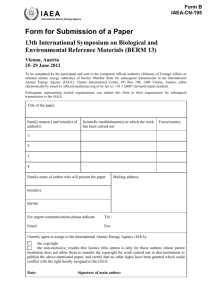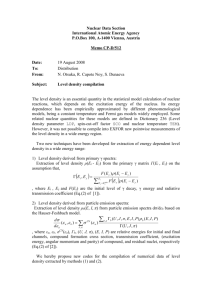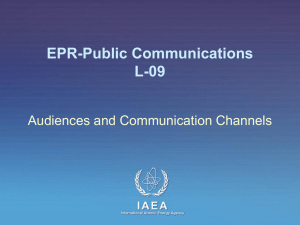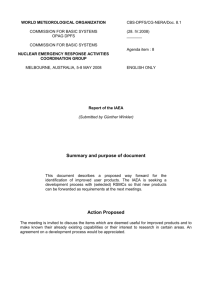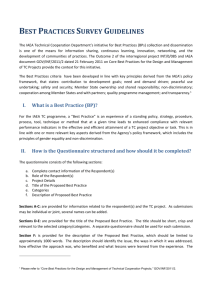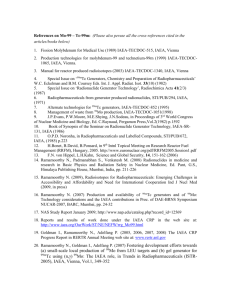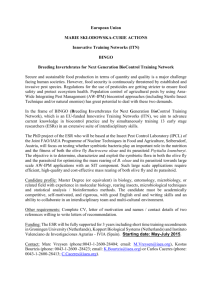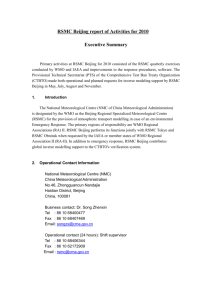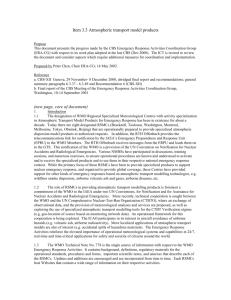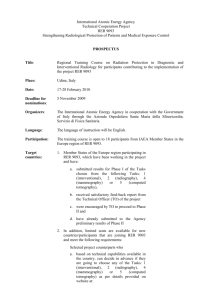IAEA
advertisement
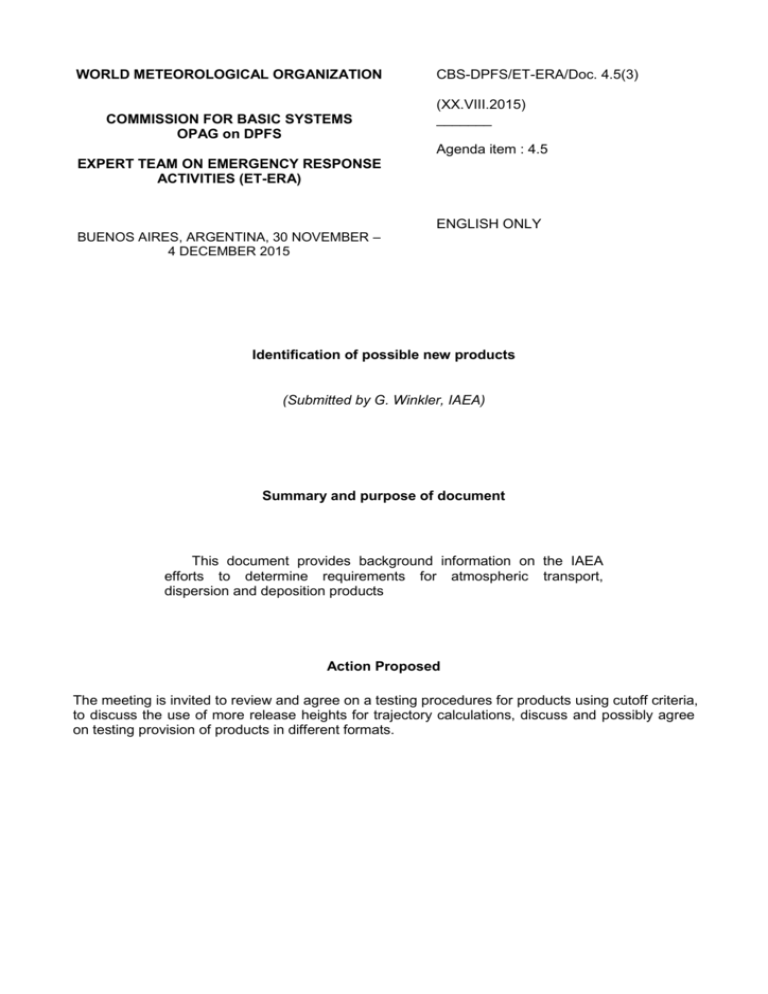
WORLD METEOROLOGICAL ORGANIZATION COMMISSION FOR BASIC SYSTEMS OPAG on DPFS CBS-DPFS/ET-ERA/Doc. 4.5(3) (XX.VIII.2015) _______ Agenda item : 4.5 EXPERT TEAM ON EMERGENCY RESPONSE ACTIVITIES (ET-ERA) BUENOS AIRES, ARGENTINA, 30 NOVEMBER – 4 DECEMBER 2015 ENGLISH ONLY Identification of possible new products (Submitted by G. Winkler, IAEA) Summary and purpose of document This document provides background information on the IAEA efforts to determine requirements for atmospheric transport, dispersion and deposition products Action Proposed The meeting is invited to review and agree on a testing procedures for products using cutoff criteria, to discuss the use of more release heights for trajectory calculations, discuss and possibly agree on testing provision of products in different formats. Background In previous meetings there were many discussions on the development/need for new products. However, different IAEA undertakings (action plans) with heavy member states involvement did not result in the definition of new products. In March 2015 a small group of contact points representing different level of arrangements for atmospheric transport dispersion and deposition products was meeting to discuss the identification of requirements. In addition, Time of Arrival products and a trial with limiting the criteria for activity concentrations have been run. Products with realistic source terms and criteria for activity concentrations During the first months of 2015 the IEC has worked on some calculations for improved products. For the time being we have developed some criteria for two radionuclides, I-131 and Cs-137 (being the most significant ones during the early and later phase of an nuclear accident release scenario). Criteria were developed for integrated air concentrations which would correlate to response measurements such as 1) take urgent protective actions 2) take protective actions and 3) potentially being able to identify the plume via an ambient dose rate measurement. Since these values are linked to potential measures the should appear on any of the products. In case the level of intergrated air concentration is not reached it should not be drawn at all. Together with these criteria a more realistic values for the marker isotope was given and the RSMCs were asked whether they could voluntarily produce such products. 1) Source term 1.0E+16 Bq Cs -137 over 6 hours Please draw the isolines of integrated air concentrations at: 1.0E+10 Bq s/m3 (if not reached don't draw the corresponding isoline) and 1.0E+7 Bq s/m3 and 1E+4 Bq s/m3 2) Source term 2.0E+17 Bq I-131 over 6 hours Please draw the isolines of integrated air concentrations at: 1.0E+11 Bq s/m3 (if not reached don't draw the corresponding isoline) and 1.0E+8 Bq s/m3 and 1E+5 Bq s/m3 3) this scenario is just a test so please use: 5E+13 Bq Cs-137 Please draw the isolines of integrated air concentrations at: 1.0E+10 Bq s/m3 (if not reached don't draw the corresponding isoline) and 1.0E+7 Bq s/m3 and 1E+4 Bq s/m3 Products were received from the RSMCs Exeter, Melbourne, Montreal, Toulouse and Washington. As we asked that the products were made available before we had a small user meeting we received as well a ToA product from RSMC Obninks, all these products were useful in the meeting. The graphs below show results from RSMC Toulouse, which show the two scenarios using Cs-137 as the radionuclide but at different source term strengths. Conclusion: This approach looks promising in addressing an issue which was stated that the current products always seem to project catastrophic consequences independent of the source term. So we would like to go further we this products in two ways: a) refining the criteria used for the products and developing criteria for additional radionuclides, and starting a testing procedure with all RSMCs (like for the ToA products). Results of a small user meeting In March 2015 we convened a small meeting with Contact Point representatives from 3 countries from which one country had a very good arrangement with their national meteorological service (the transport, dispersion and deposition calculations are fully integrated in the system of the National Competent Authority). The second country had a well a well-functioning arrangement with the national meteorological service but in this case the National Competent Authority received products from their meteorological service (there was no processing at the competent authority). The third country had limited arrangements with their national meteorological service but received some products (limited in distance from the national borders) from developed neighbouring countries. We discussed the different phases of an large scale nuclear emergency and talked about the different arrangements the countries have and what their expectations towards the IAEA are. Some conclusion that were drawn from this meeting: The current set of products were developed for the IAEA Secretariats needs and do not necessarily address all of the member states needs Member states with less arrangements with their national meteorological services will rely on the IAEA products, and would prefer products which would have information about radiation doses The further away the accident state is from the Member State the more likely are they to use the IAEA products Member states with good arrangements would use IAEA products if they came in a format which they could use (GRIB, shape files, geotiff), they could also imagine that they (as a country) request these products from the RSMC Ensemble products could be beneficial for expressing uncertainties (no strong demand for ensemble products was gathered from the meeting) There is a need for different products at different times of a nuclear emergency Early phase (before a release) o Trajectories are appreciated, however the corresponding release heights could be extended to cover lower level releases (30 and 100 m) o As long as there is no release the trajectories should be made available more often o The joint statement is appreciated, as an statement on meteorological assessment provides additional benefit. The joint statement should as well describe the uncertainty associated with the products and whether the product would change a lot if the release would happen earlier or later. Release phase o Time of Arrival products would be much appreciated. o Later dispersion and deposition products Later phase o Mainly dose assessment products are needed (task for IAEA only)
